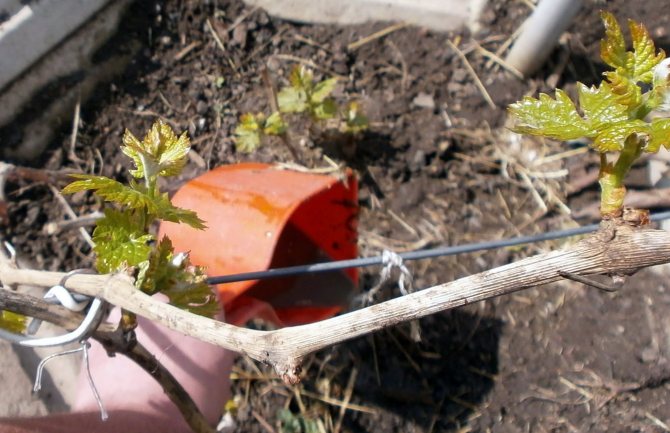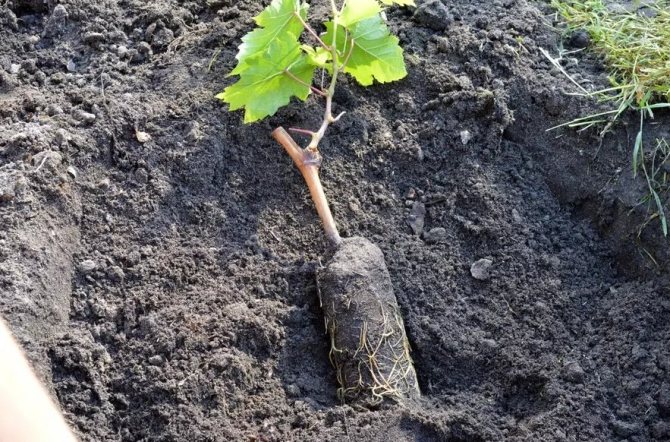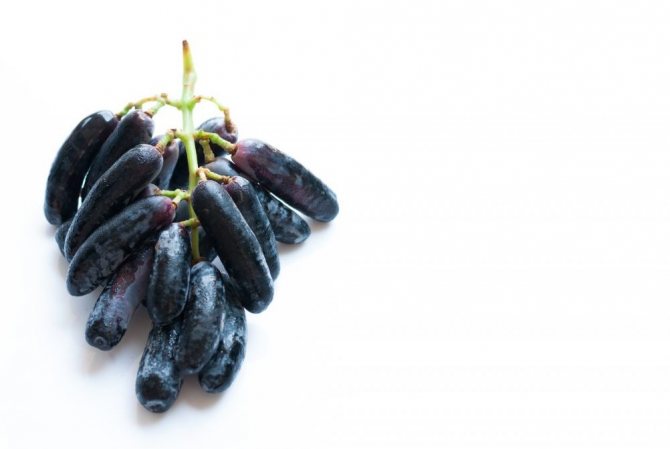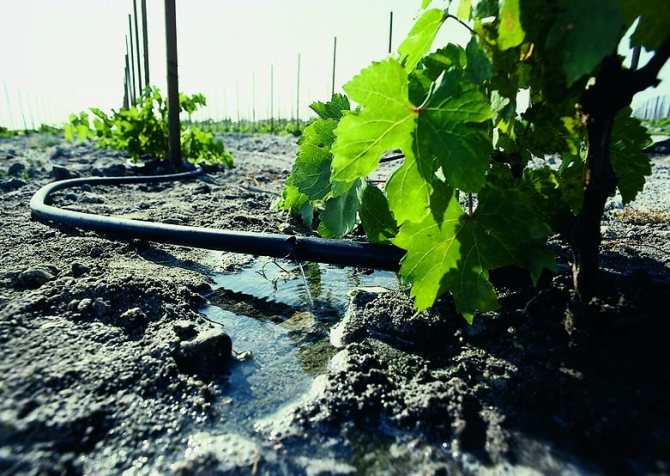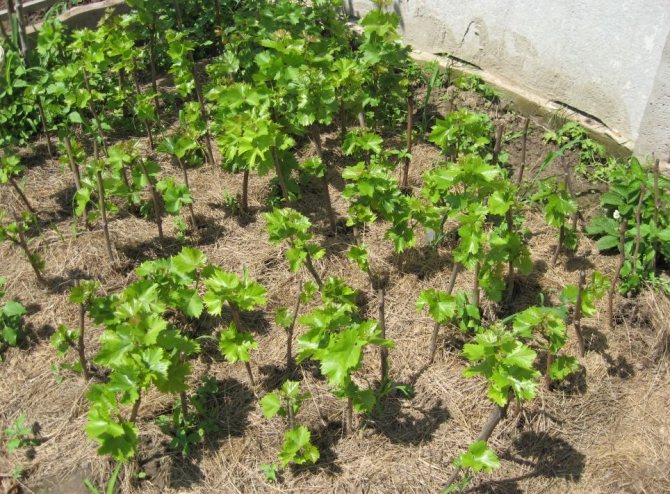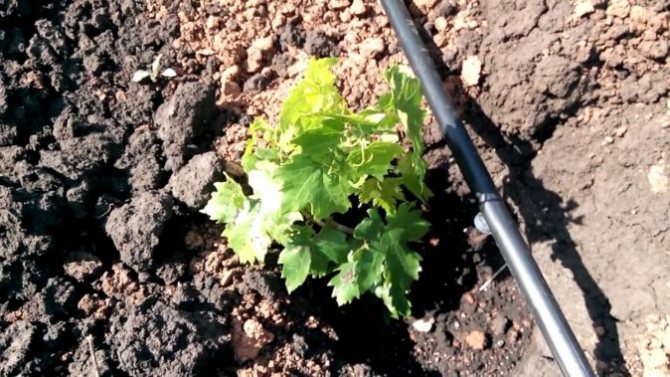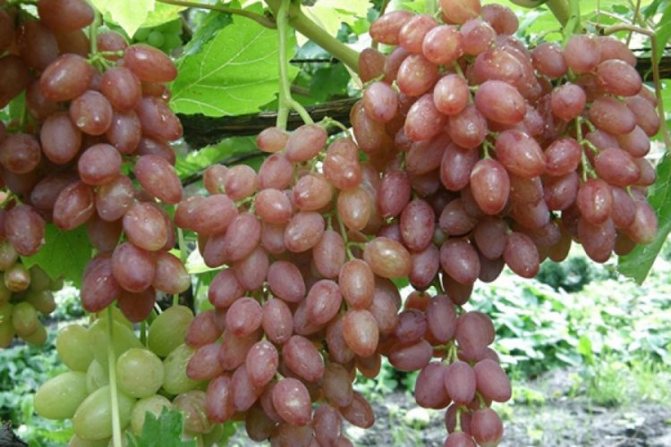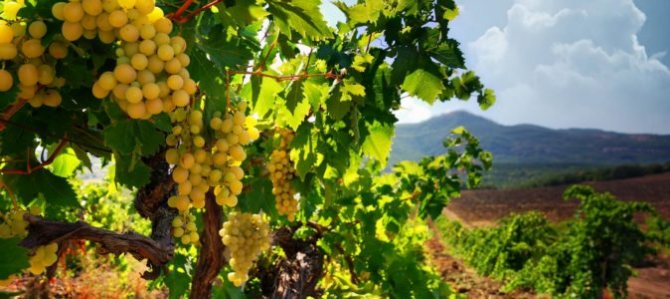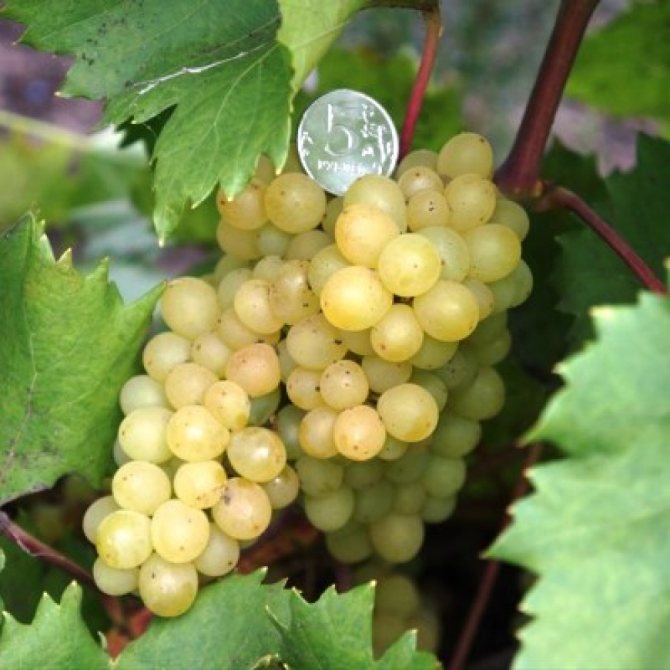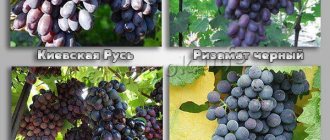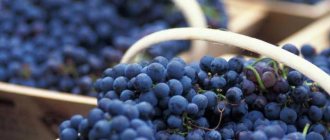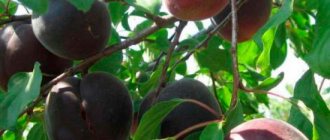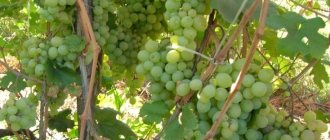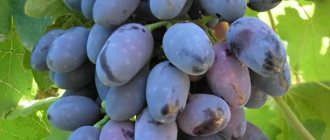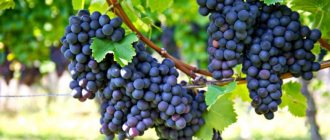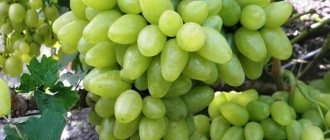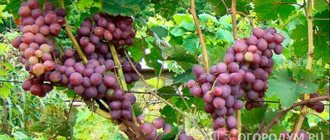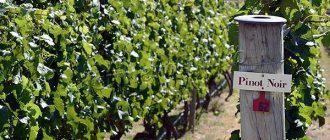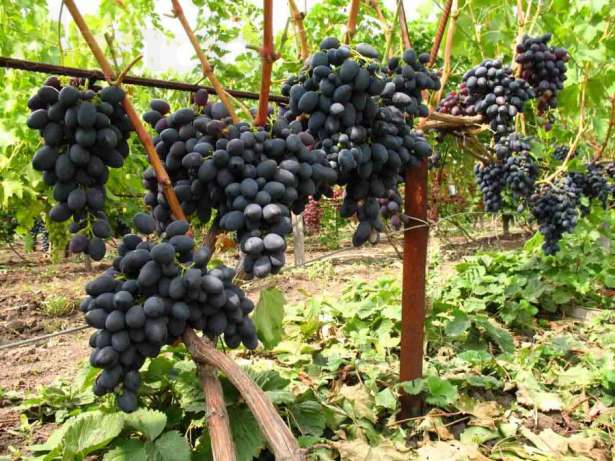
Most people love grapes. It is rich in glucose and fructose, which make it one of the sweetest fruits grown by humans. In addition to its excellent taste, it also has great benefits. Ripe fruits contain many vitamins and minerals necessary for the normal functioning of the body. Grapes also help with some diseases, for example, with a cold. It contains pectin, which stimulates the gastrointestinal tract. The presence of grapes in the diet stimulates the production of hemoglobin and improves skin condition. Among the many varieties of this fruit, black raisins are very popular, since its grapes do not contain seeds.
Description and characteristics of black Kishmish grapes
The grapes of this variety are mid-season, table. The bush is vigorous, the length of the vine is up to 2-2.5 m. Its leaves are medium-sized, strongly dissected, three-lobed, dark green. The flowers are bisexual, emerald hue. The berries ripen 3 months after the beginning of flowering.
Bunches of the Kishmish variety are in the form of a cylinder, dense, their weight is 300-700 g. The berries are not very large, oval, elongated at the top and slightly flattened at the bottom. One berry has a mass of 2.7-3 g, dark blue with a gray waxy bloom. The pulp is juicy. The taste is delicate, fruity, high sugar content, 22-27%.
Dark Kishmish is used in a fresh, dried form, compotes are made from berries, raisins are in demand in baked goods.
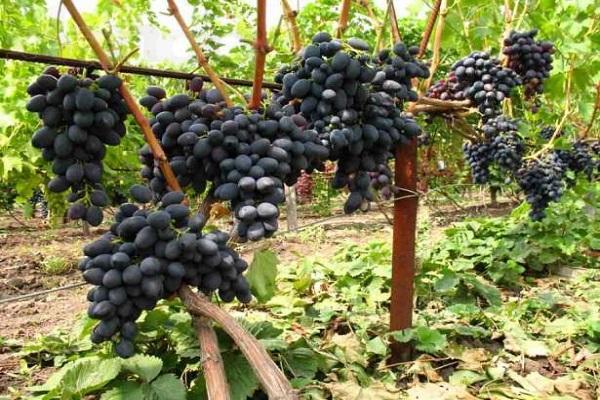

Beneficial features
- This variety is used to make raisins, which contain a large amount of potassium, which is one of the most essential trace elements for humans.
- Berries of this variety have a positive effect on the cardiovascular system.
- Raisins contain a lot of boron, which prevents the development of osteoporosis.
- Grapes of this variety contain antioxidants that slow down the aging of the body.
- Kishmish is used in the food industry, it is added to cakes and other sweet products.
Pros and cons
Kishmish has a number of advantages:
- berries do not contain seeds;
- brings a large harvest - 250 centners per hectare;
- you can transport brushes over long distances;
- easy to care for, like other varieties;
- berries do not crack in rainy weather;
- used for the preparation of wines, dried fruits, soft drinks.
The disadvantages of the variety are intolerance to low temperatures, susceptibility to diseases - oidimum, anthracnose and attacks of pests - wasps, leaf rollers. After ripening, the berries must be removed immediately, otherwise they will lose their taste.
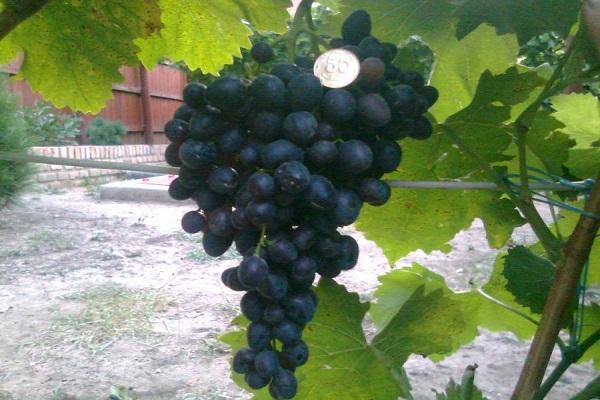

Application
Kishmish is a very tasty and juicy berry, which is used not only in cooking, but in various industries and spheres of human life. Let's consider in more detail.
In cooking
Kishmish, like other varieties, is eaten fresh, grapes are put in a variety of salads, desserts, and also used for decoration. Jam and jams are made from it, which are later used as a filling for baking.
But the most important thing is that raisins of golden color are made from grapes, with a pleasant taste and unique aroma. A variety of drinks are also prepared from it: juice, compote, white and red wine.
In medicine
- Decoctions and infusions are prepared from raisins to help fight cough.
- Raisins from this variety are used to prepare a mixture of dried fruits, which helps to improve immunity and the functioning of the gastrointestinal tract.
- Decoctions and infusions have a cleansing effect, therefore they are used to cleanse the body as a whole.
When losing weight
This is far from a dietary product, but if you eat grapes correctly, it will help to put the forms in order.
It is enough to eat 60 g of grapes per day as a separate meal. Eating raisins will help prevent excessive production of the stress hormone, against which the body often begins to accumulate excess. And eating several berries a day will reduce the amount of sweets consumed.
In cosmetology
In cosmetology, grapes are used as an ingredient in a mask for skin and hair. There are many recipes for preparing these funds. Hair masks last no more than 45 minutes, and for face - 10-15 minutes.
Growing features
They take into account the timing and choose the right place for the grape variety.
Planting period
Kishmish grapes are planted in autumn or spring, in cold regions it is advised to do this in spring. Over the summer, the root system will strengthen. In the south, this variety can be planted in the fall. They purchase material for planting in specialized stores, nurseries, where there is a guarantee.
See also
Description and characteristics of the Delight grape variety and its varieties, planting and care featuresRead
Site preparation
A place for a perennial plant is chosen free, unshaded, protected from the wind. The best option is south, southwest with a slight slope.
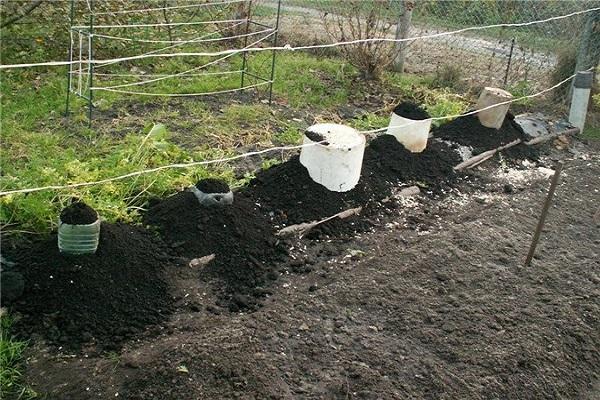

Sandy loam, loamy, chernozem, chestnut soils are suitable for the Kishmish variety. The site is dug up in advance and humus is introduced - 3-4 kg per 1 sq. m and superphosphate - 100 g per 1 sq. m. Phosphorite flour is added to acidic soil, coarse-grained sand is added to clay soil.
Planting process
The grape bushes are planted at a distance of 2.5 m, between the rows - 3 m. The roots of the seedlings are pruned, put in water for 1-2 days.
First, they dig holes 80 x 80 cm in size. Drainage from gravel is laid at the bottom. The earth is mixed with rotted manure, superphosphate, potassium salt. The seedling is installed, sprinkled with soil, leaving 2 eyes above the surface. Water using two buckets per bush. They put special supports - posts with stretched wire. The soil is mulched with straw, rotted sawdust.
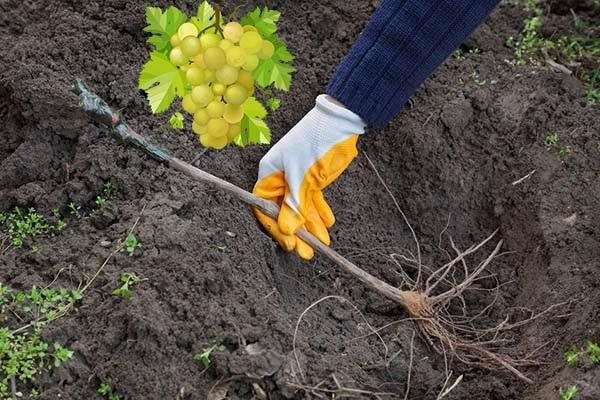

The specifics of plant care
In May, the grown grape vine is tied up, in June - pinched, shoots are removed. In July, pinch the tops. The trunk circle is cleared of weeds, loosened. The bush is formed in different ways - in the form of a fan sleeve or formation on a trellis. Weak, sick, frozen shoots of grape varieties are removed in the spring.
Watering and fertilizing
Strong watering is not required for Kishmish. Every 4 days, 2-3 buckets of water are needed for a variety bush. It is better to apply drip irrigation. Watered in the spring before and after the blooming of the shoots, during active growth. Do not water for 2 weeks before harvest.
Before the growing season, fertilizers with nitrogen are applied under the grape bush, then phosphorus-potassium fertilizers. In autumn, nitrogen fertilization of the grapes is not required, organic matter is introduced, then complex mineral mixtures.
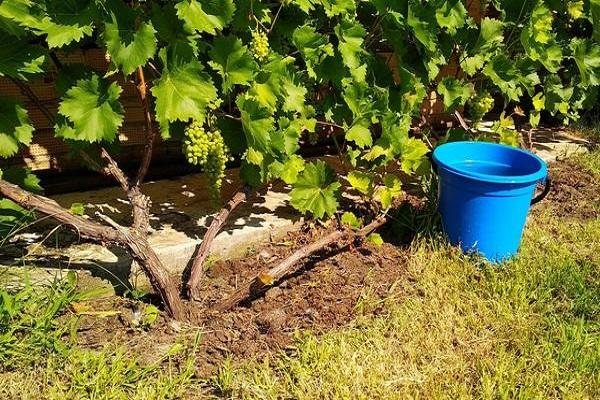

Preparing for the winter period
In the fall, the vine is pruned. The formation of a bush variety assumes 8-10 shoots per running meter. Leave at least a meter between the sleeves.
After removing the berries and pruning before the onset of cold weather, the bushes are treated with solutions of iron and copper. Fallen leaves are removed.
To protect from the cold, the vine is tied up and laid in dug trenches to a depth of 20 cm.
Sprinkle with soil, making a mound of 30 cm, or use agrofibre and create a canopy of branches. In addition, you can use straw, corn stalks.


Breeding history
Homeland of the Black Emerald - United States, California Agricultural Laboratory. It was bred by crossing FRESNO A69-190 and FRESNO C84-116 by breeders David Ramming and Don Tarailo. Their goal was to create early and frost-resistant raisins.
Indeed, The Black Emerald is one of the earliest ripening Sidlis. From the USA it got to Ukraine, then spread to the southern territories of the former Soviet Union.
Also native to America are Buffalo, Witch's Fingers and Alpha.
He feels best in the Luhansk region and the Black Sea coast. He is afraid of more northern territories because of his heat-loving nature.
Description of diseases and pests
Diseases are common in grapes. For prevention, you need to spray the bushes with Bordeaux liquid or take "Ridomil Gold". Multiplicity - three times per season. This is done in the fall, after the leaves have fallen, in early spring before bud break, during the growing season when the shoots reach 12-15 cm.
See also
Description and characteristics, pros and cons of Zest grape varieties and growing rulesRead
Oidium
Powdery mildew appears at first as small white spots on the buds. Then a white bloom forms, turning into brown spots with an irregular gray bloom and a moldy smell. Inflorescences stop growing, dry out, fall. If the berries are affected, they burst, harden and rot. The vine is processed before and after flowering. Repeat after 20 days and in early August. Preparations for oidium - colloidal sulfur, "Strobi", "Vectra", "Tilt".
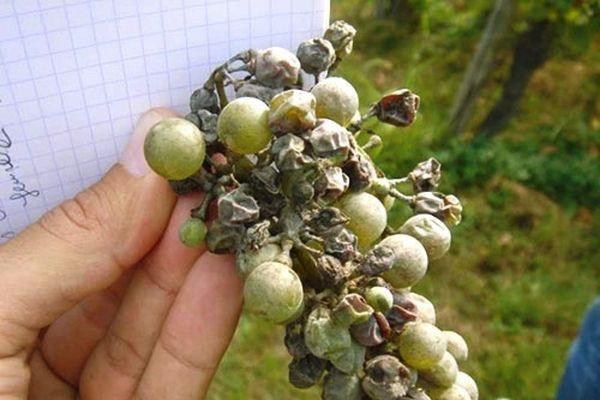

Mildew
Fungal spores germinate in wet weather. Leaves and veins have yellow oily spots. On the underside there is a gray fluff, then it goes to buds, flowers. The berries turn brown, burst, and drain out of juice. The bushes need to be ventilated, the affected parts must be burned, treated with fungicides - copper oxychloride, "Poliram", "Thanos", when a fungus appears and for prevention.
Pests
The grape loves grapes. She feeds on ovaries, berries. When it appears, insecticide treatment is needed.
To protect juicy berries from the invasion of wasps, they are driven away with smoke or special bags are put on each bunch. Place trap glasses with poisonous bait. In some cases, chemical treatment is used.
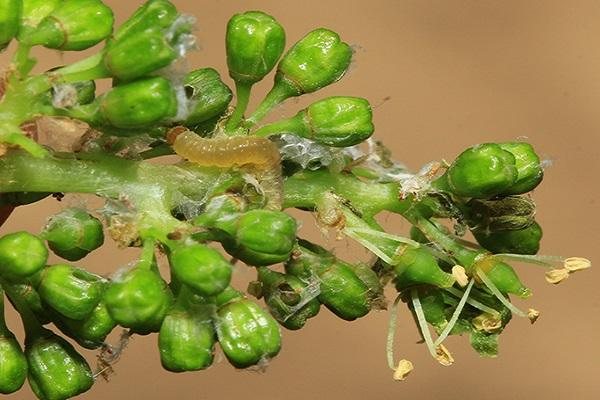

Varieties of black kishmish
Kishmish has several varieties with excellent taste of berries and immunity.
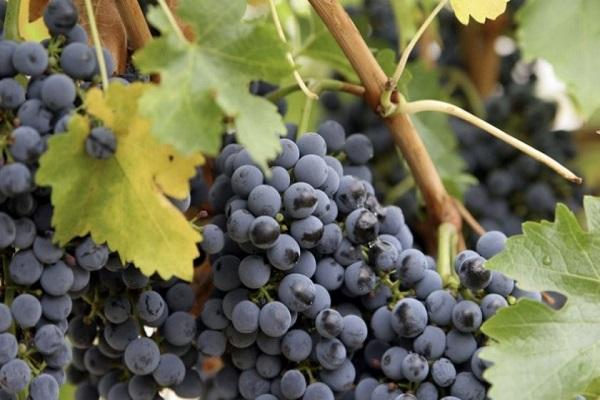

Black finger
The second name is Black Finger, bred in Israel. The variety is distinguished by elongated large berries up to 3 cm long, weighing up to 14 g. Its clusters are 1-1.5 kg. The skin is firm. Has immunity to diseases, withstands frosts down to -20 C. Delicious, sugar content 20%. After the start of the growing season, it ripens in 150 days.
Black emerald
It is called Black Emerald. Early variety, American. From the beginning of the growing season, the berries ripen after 105 days, at the end of July. Bunches weighing 400-600 g, berries 3-6 g with dense pulp. The brushes weigh 500 g. Its yield is very high, but it is not resistant to diseases. It tolerates a temperature of -23 C.
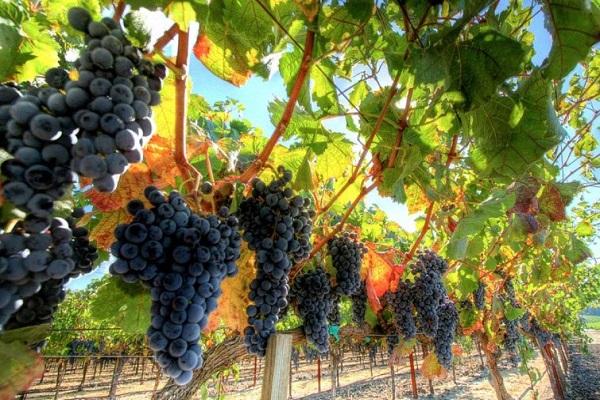

conclusions
Black kishmish - grapes of an early ripening period, therefore, it is almost not affected by mildew. Unpretentious care. The rules of agricultural technology are the same as for other varieties: loosening, feeding, watering, pest and disease control.
Black kishmish is one of the oldest traditional grape varieties of the eastern ecological-geographical type, cultivated in the Central Asian republics since time immemorial. For hundreds of years of cultivation, it has spread in many areas, where it became known under a variety of names: Shuvargan, Kara-kishmish, Black Monukka, Kishmish this. In the post-Soviet space, the variety is actively cultivated in Uzbekistan and Tajikistan, to a lesser extent in Kyrgyzstan and Turkmenistan. In most of these countries, it is zoned and introduced into the standard assortment. Outside of the main distribution area, it is sometimes cultivated by hobbyists experimenting with exotic forms of grapes.
The origin of the variety is currently unknown, it is only assumed that it originally appeared in Central Asia together with the Turkic tribes that developed these territories. Subsequently, it was actively used when crossing as a paternal form to obtain new high-quality hybrids of the sun berry.
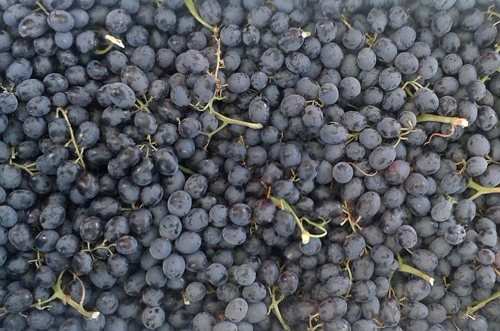

The main advantages of Black Kishmish, which determined its popularity, are high yield and excellent gastronomic characteristics of fresh and processed fruits. But, at the same time, like many other oriental seedless varieties, it is distinguished by its extreme delicacy and low resistance to unfavorable environmental factors. In this regard, its cultivation requires a competent approach from the grower and careful implementation of the necessary measures for plant care.

